How To Use A Diamond Selector 2 Diamond Tester
Do you have diamonds and y'all can't tell if they are existent or fake? A diamond selector or tester is your go-to tool.
Due to the popularity of and desire for diamonds, it is possible you have heard many means to check how existent or fake a diamond is. Simply in that location is no way to test it that is meliorate than using a diamond selector or tester.
Therefore, let me guide you lot on how to use a diamond selector correctly.
Using a Diamond Selector
There are different types of diamond selectors if you are going to find out if a diamond is real or fake. Bear in heed that many fake ones grow.
But here, I will testify you how to use a Diamond Selector II.
Testing a Diamond with a Diamond Selector II
On this diamond selector, you will run across a low-cal segment and a knob marked Book. The knob has Off and On marked on either side of it.
The light segment has numbers nether it, from 1 to 8. After number 8, you run into DIA, which stands for diamond. These numbers determine the sensitivity you set for each type of stone size. The bigger the stone, the lower the number y'all get-go from.
And if a stone is real diamond, the light on the segment will move pretty speedily upwards to DIA.
A chart at the back of the selector shows you how to set the sensitivity. And there is a metal bar at the back. Proceed your fingers on it while testing the stone.
The tip has a prophylactic cap over information technology. Remove the cap and you will meet the examination tip that looks like a needle.
The following are guiding steps on using a diamond selector:
Stride 1: Set up the Volume or Sensitivity
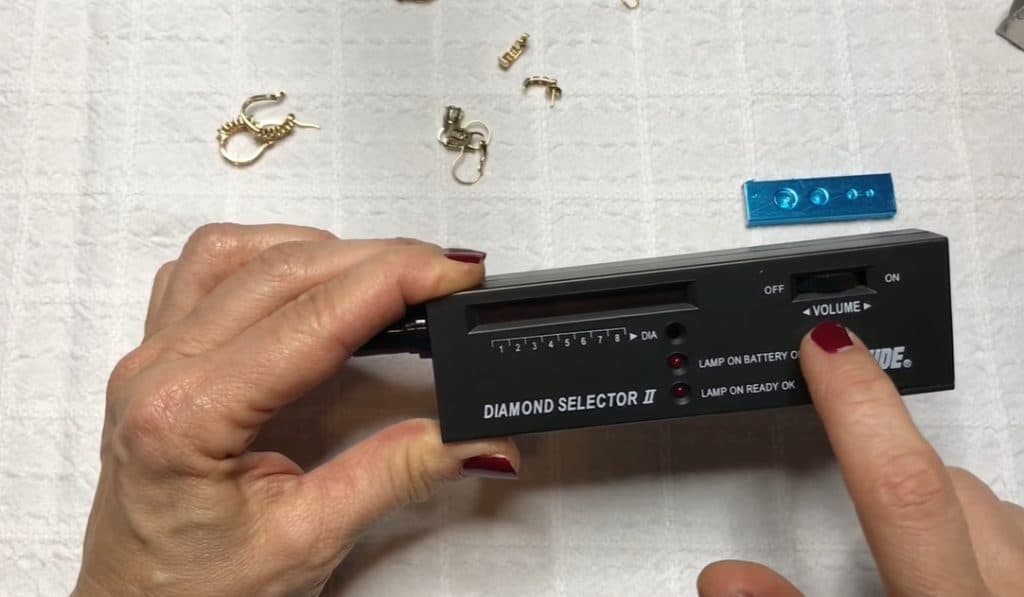
To begin, detect the knob on the selector marked volume. Turn it to activate the selector. The Battery OK light volition come on.
Expect about twenty seconds for the Ready OK light to come on. So, turn the knob once again until the low-cal on the segment reaches the right spot.
Remember to gear up the number according to the size of the stone yous want to test. The bigger the rock, the lower the number you fix. And the smaller the stone, the higher the number you set up.
Step two: Uncap the Selector
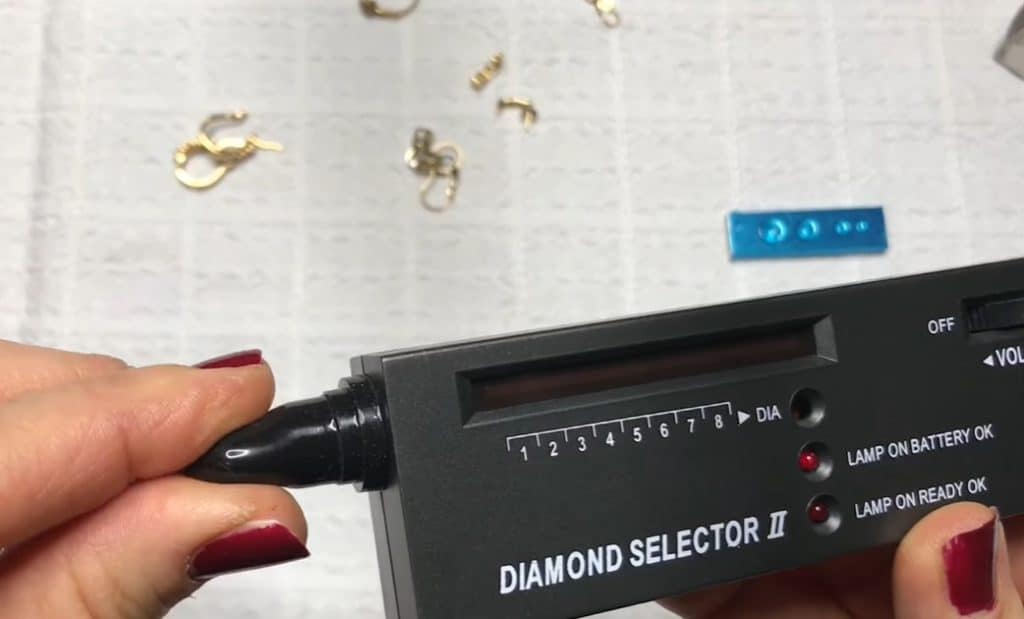
Equally soon as the calorie-free comes on, take the rubber cap off the tip of the selector. The cap protects the tip and then practice this gently.
Place the cap in a safety identify and then yous don't lose it. There is no other way to protect the fragile tip of the selector.
Step iii: Test the Diamond
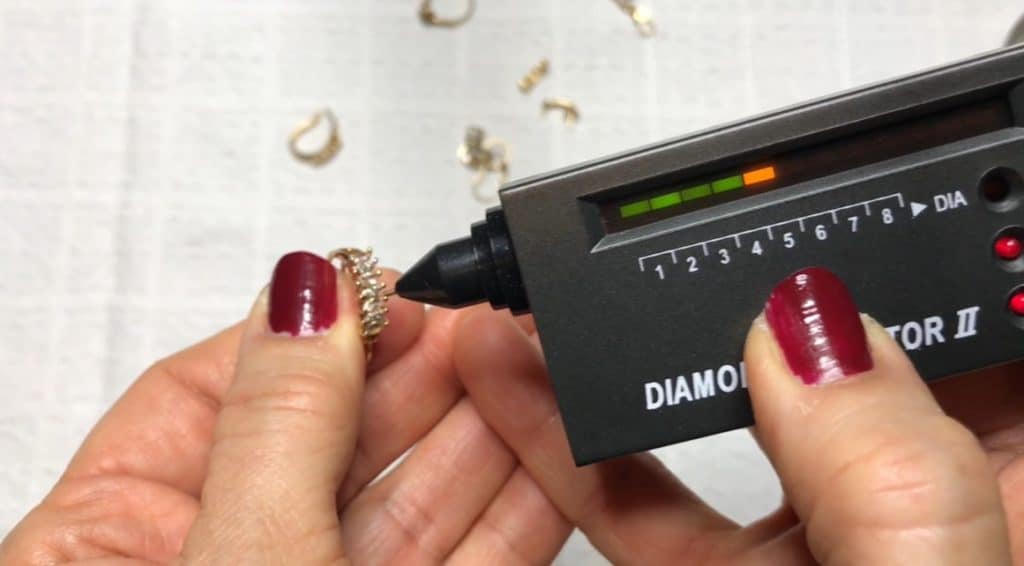
When the segments low-cal up, press the test tip of the selector on the diamond y'all want to test. Exercise this firmly and at a right angle to get the right result. Yous will need a steady hand.
Simply pressing the test tip is enough. Don't move information technology on the diamond or yous risk breaking it due to the hardness of the gemstone.
While pressing it, keep your manus on the metal bar on the selector's back. This way, even if you miss pressing the stone and y'all bear upon its setting accidentally, it will trigger an alarm to alarm you.
Step iv: Interpret the Result
- If the lights don't change or motion, information technology means the stone you have is non diamond.
- And if the lights illuminate slowly and doesn't read diamond, it means the stone is likely another gemstone like sapphire.
- Withal, if the lights exceed 9 on the selector, up to Diamond, it means the stone you have is diamond. All the lights on the bar, from light-green to cherry, will light up and there will be a beep.
Put the rubber dorsum on the exam tip when yous are not using it.
One examination may non satisfy yous so you may want to run several more than to be sure. So I want to indicate out hither that you take to wait to see the lite marked Ready come on before yous go once more.
And it is of import I permit you lot know that if you keep running tests on that same diamond, it would become warm.
A warm diamond won't read correctly then some of the tests may be incorrect. Therefore, permit the diamond to absurd if it gets warm before y'all run more tests.
Sensitivity
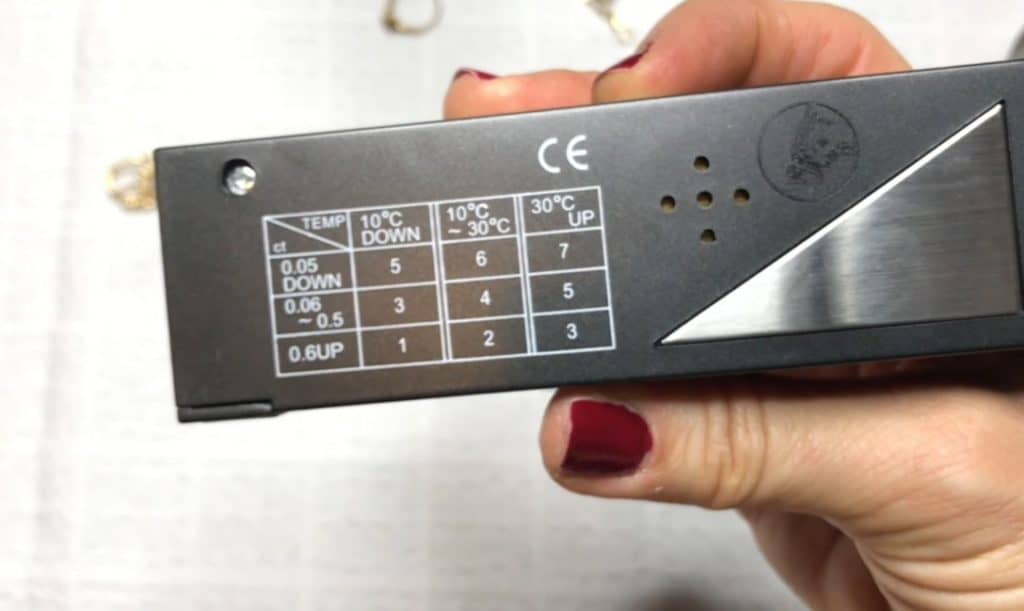
The sensitivity you use with this selector will depend on the size of the diamond and the weather.
And then to set it, turn the Volume knob until the segments light up. Have a look at the number chart on the label of the selector. If the temperature where you are is not cold, set the start number at iv if y'all have a small-scale or medium-sized stone. Merely if you take a big stone, choose 3.
However, if the temperature where you are working is common cold, consult the number chart. It will guide you on which segment number to get-go from.
With time, y'all will understand how a diamond selector works. Yous may non fifty-fifty need to consult the number nautical chart anymore if y'all continue using it.
Of import Notation
The LED lights are what tell you whether or not the stone you have is a diamond. The starting number does non exactly thing. But information technology is there to guide you lot until you lot grasp how to use the selector.
So if the lights move quickly, lighting up as they go, yous know you have a diamond. This is even if you start at the wrong kickoff number. But if they are boring, you may not have a diamond.
As well, diamonds at different temperatures react differently to the test. If you lot grab a stone from where directly sunlight hits it, it will react more slowly to heat than i at room temperature. And if the stone is cold, information technology volition react to oestrus very rapidly.
What Is a Diamond Selector?
A diamond selector is a small device used to check the actuality of diamonds. You can behave it in your pocket; it is that modest.
It has a tip that looks much like a needle and is fragile. It is this tip you will place on the stone you desire to test.
A real diamond will elicit a beep from the selector or information technology will show it is diamond on its display.
Some diamond selectors apply electricity in the place of rut. A few even combine electricity and oestrus.
The principle of operation does not modify. All the same, instead of detecting how a stone conducts heat, it detects electricity. This style, it decides whether or not the stone is a diamond.
How Does a Diamond Selector Piece of work?
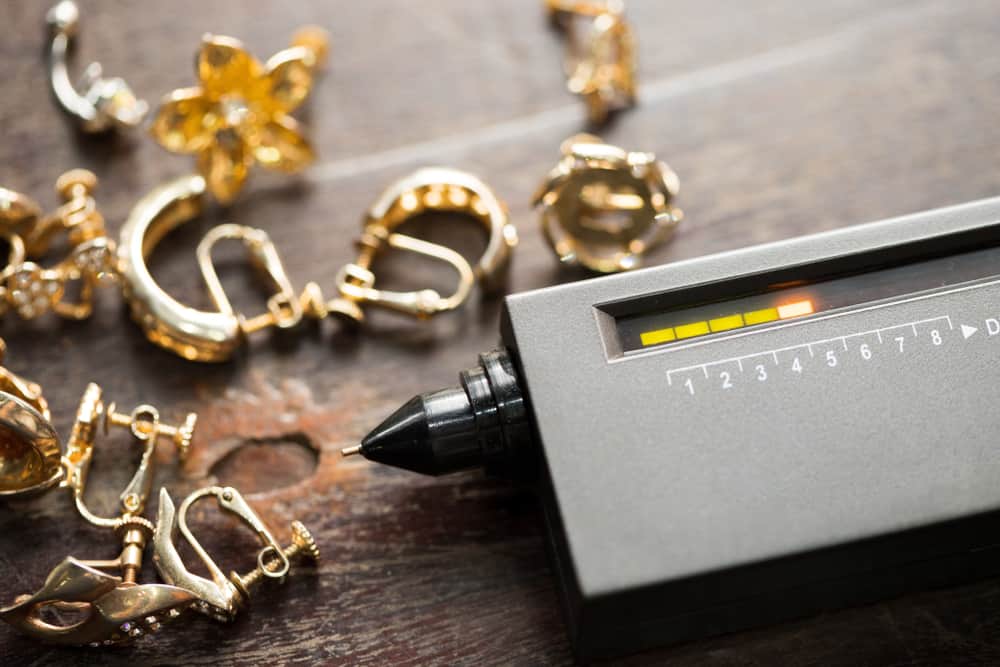
All gemstones don't bear heat the same way. So a diamond selector operates based on this principle. If you identify a cubic zirconia rock side by side with a diamond, each will comport oestrus differently. This is even though they wait alike to the naked eye.
Based on this, a diamond selector monitors the fashion in which a stone conducts heat and determines whether or not it is diamond.
A diamond is normally cold, temperature-wise. Placing it to your lips volition tell you how cold it is. Now, the tip of a diamond selector heats up and when you place it confronting the stone, the selector checks this coldness by how quickly heat moves through it.
The quicker the heat gets fatigued into the diamond, the further and quicker the lights on the selector motility.
Different rock sizes take differing degrees of coldness. Therefore, if a diamond is small, its coldness will be low. That is it will feel more warm than cold. Then it will carry heat slowly.
In the aforementioned vein, if a diamond is big, the heat will move quicker. However, the slowness of the movement does not hateful information technology is not diamond. It could merely be that the rock is also modest.
A cubic zirconia stone, for example, won't even conduct the heat at all because it is warm. And a large sapphire, for example, may conduct some heat but not much.
Reliability of a Diamond Selector
Despite the fact that a diamond selector is pretty reliable, it can also make mistakes. It cannot tell the difference between a moissanite and a diamond.
This is because a moissanite and a diamond deport heat just the same. However, they don't behave electricity the same way.
Therefore, if you are not certain the stone you have is diamond, use a diamond selector that tests with electricity. This manner, you are absolutely sure.
Conclusion
To wrap things upwards, using a diamond selector involves the following:
- Setting the sensitivity
- Uncapping the selector
- Testing the diamond
- Interpreting the upshot
Setting the sensitivity is important but not as of import as the speed at which the lights move on the segments. The speed actually tells you whether or not you lot accept real diamond.
I know it looks similar a lot correct now but trusts me, you volition get the hang of it with time. However, if you have any questions, experience free to ask them in the comments section.
How To Use A Diamond Selector 2 Diamond Tester,
Source: https://somethingborrowedpdx.com/how-to-use-a-diamond-selector-2/
Posted by: elliottviaguld99.blogspot.com


0 Response to "How To Use A Diamond Selector 2 Diamond Tester"
Post a Comment